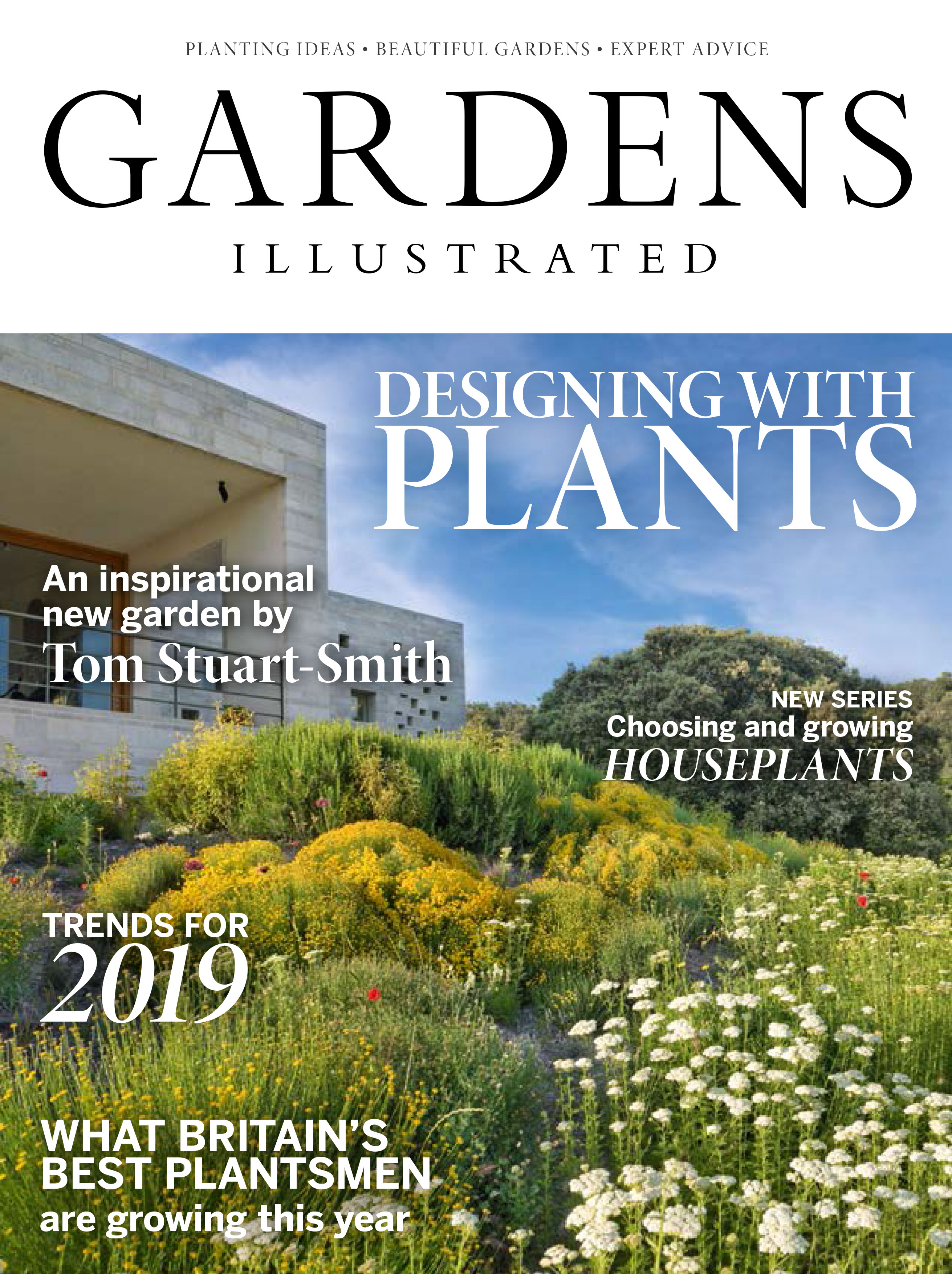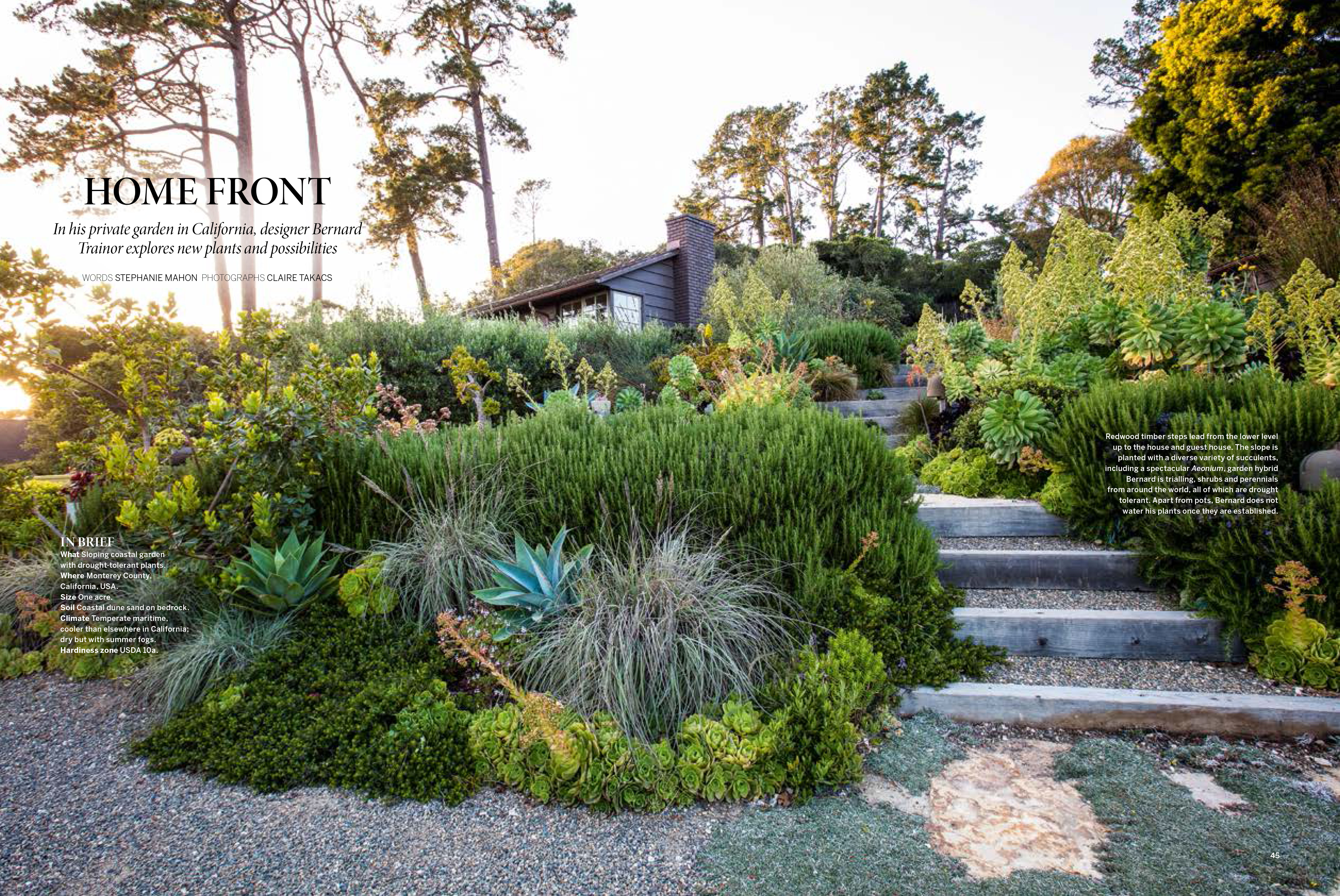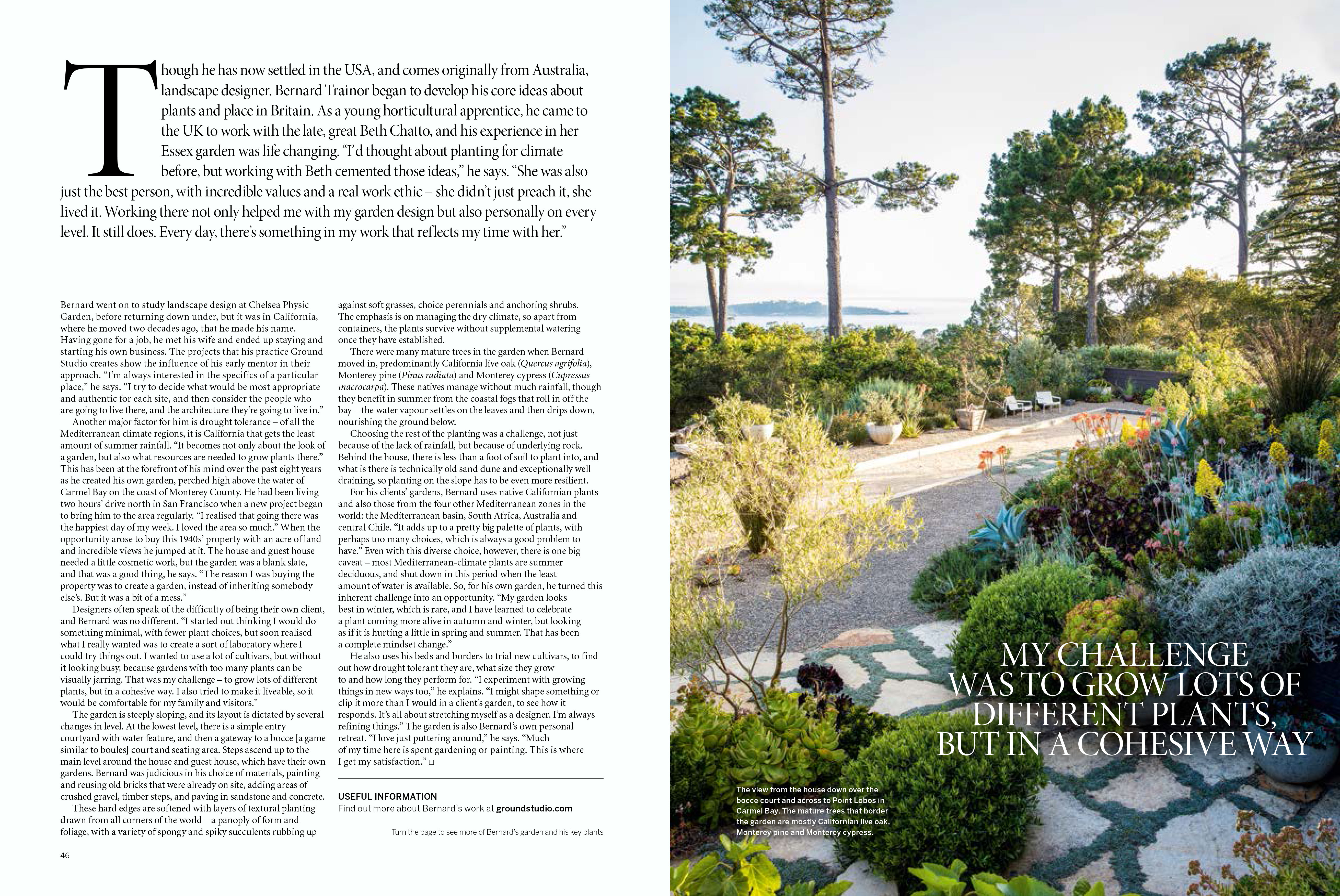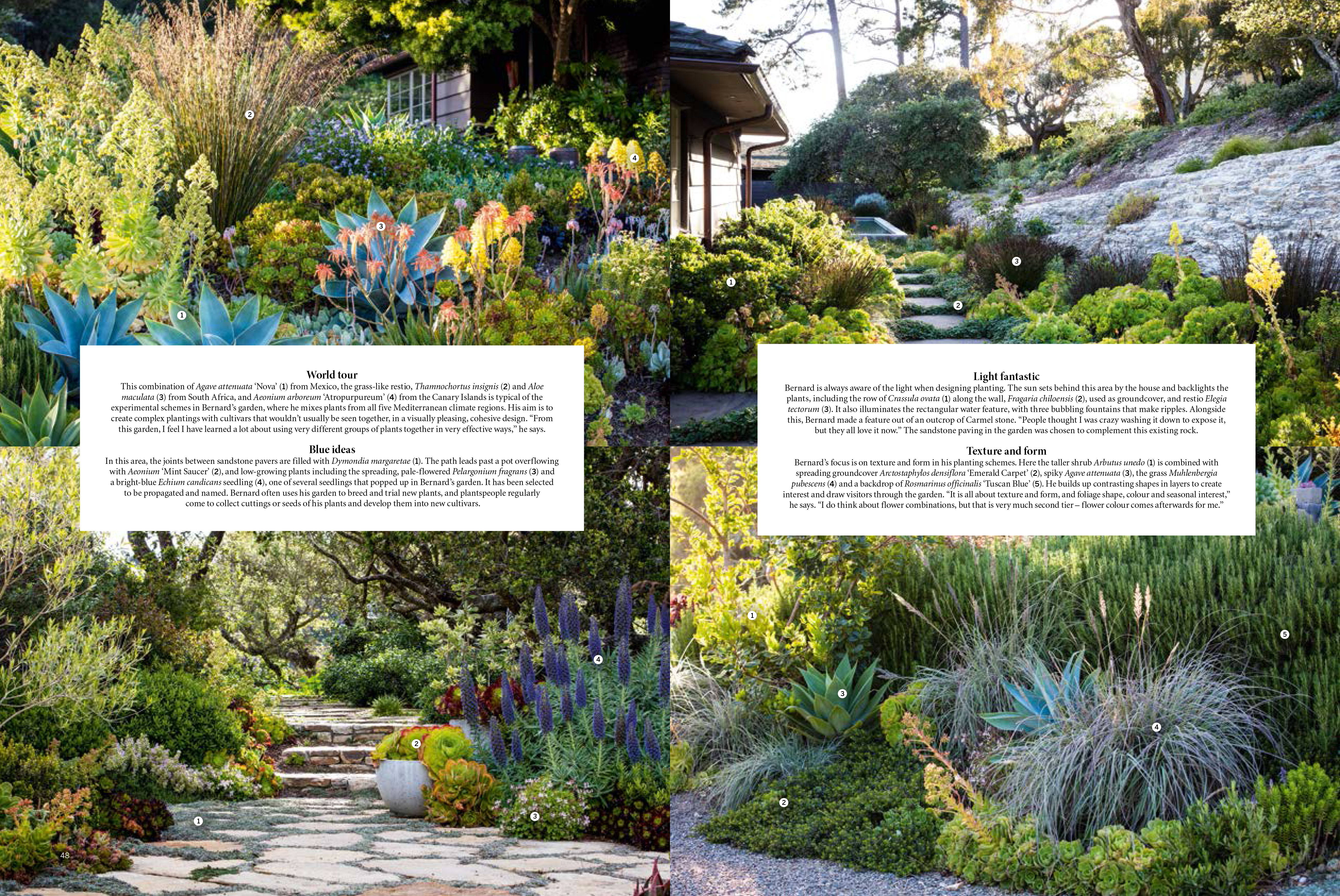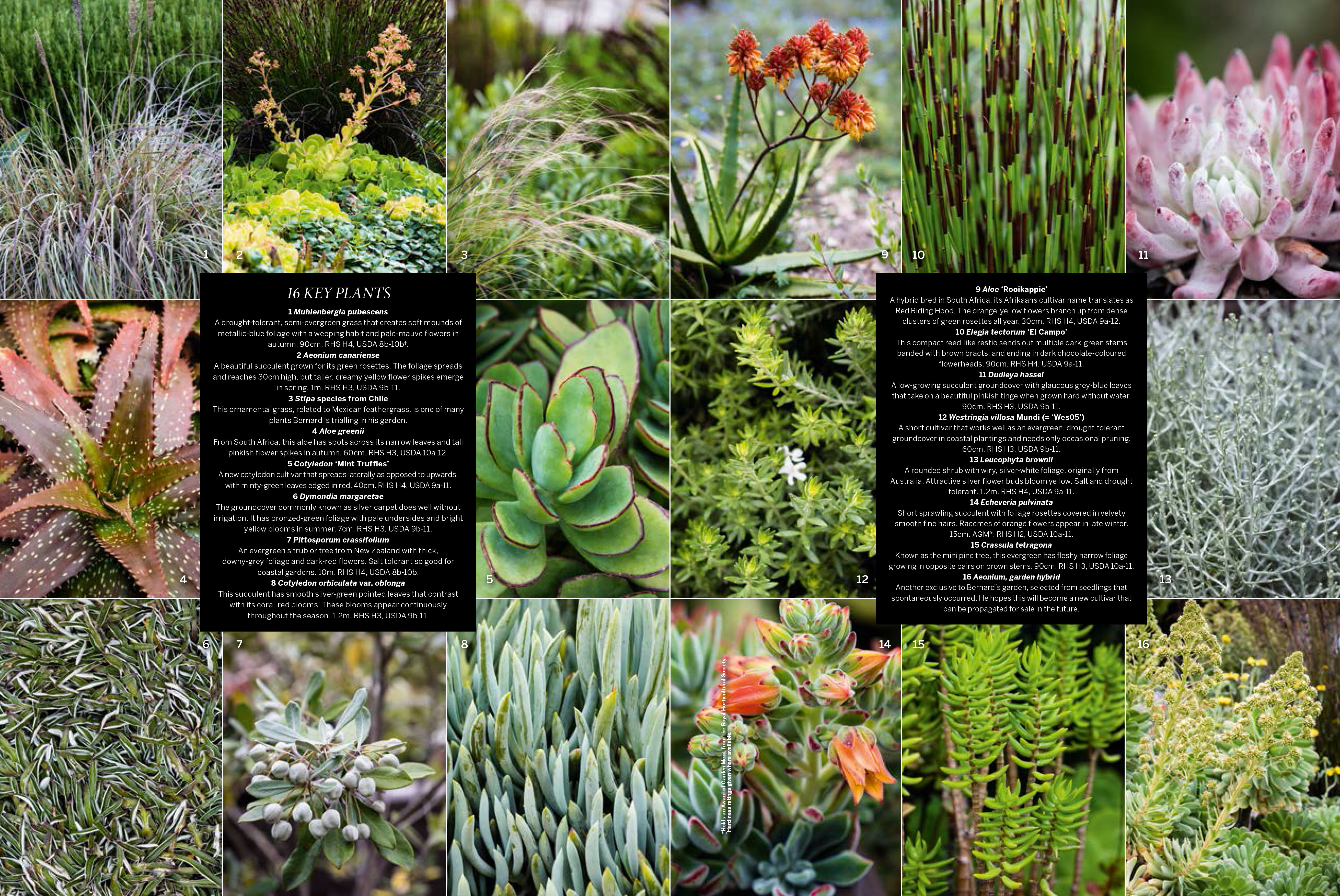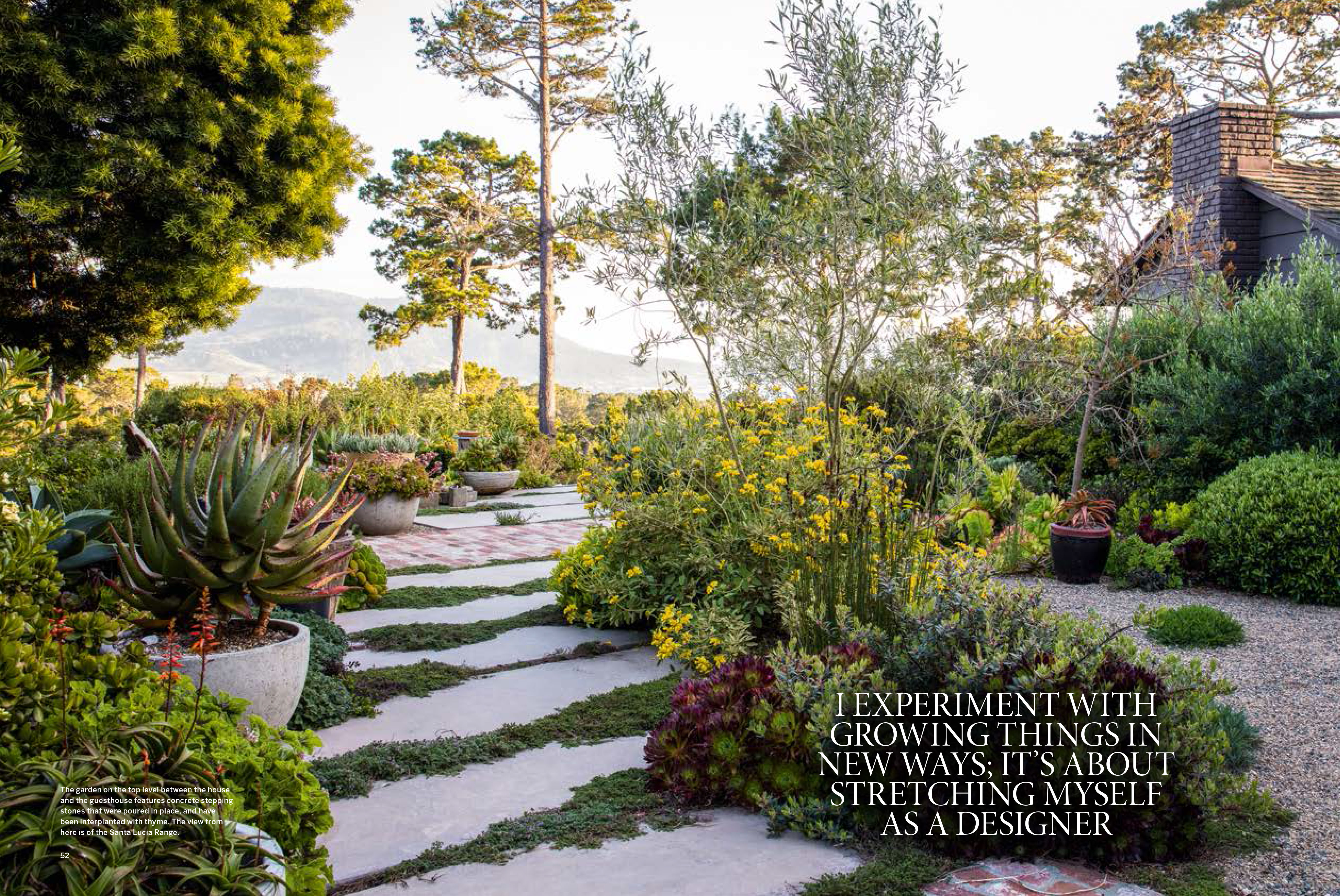HOME FRONT
In his private garden in California, designer Bernard Trainor explores new plants and possibilities.
Though he has now settled in the USA, and comes originally from Australia, landscape designer. Bernard Trainor began to develop his core ideas about plants and place in Britain. As a young horticultural apprentice, he came to the UK to work with the late, great Beth Chatto, and his experience in her Essex garden was life changing. “I’d thought about planting for climate before, but working with Beth cemented those ideas,” he says. “She was also just the best person, with incredible values and a real work ethic – she didn’t just preach it, she lived it. Working there not only helped me with my garden design but also personally on every level. It still does. Every day, there’s something in my work that reflects my time with her.”
Bernard went on to study landscape design at Chelsea Physic Garden, before returning down under, but it was in California, where he moved two decades ago, that he made his name. Having gone for a job, he met his wife and ended up staying and starting his own business. The projects that his practice Ground Studio creates show the influence of his early mentor in their approach. “I’m always interested in the specifics of a particular place,” he says. “I try to decide what would be most appropriate and authentic for each site, and then consider the people who are going to live there, and the architecture they’re going to live in.” Another major factor for him is drought tolerance – of all the Mediterranean climate regions, it is California that gets the least amount of summer rainfall. “It becomes not only about the look of a garden, but also what resources are needed to grow plants there.” This has been at the forefront of his mind over the past eight years as he created his own garden, perched high above the water of Carmel Bay on the coast of Monterey County. He had been living two hours’ drive north in San Francisco when a new project began to bring him to the area regularly. “I realized that going there was the happiest day of my week. I loved the area so much.” When the opportunity arose to buy this 1940s’ property with an acre of land and incredible views he jumped at it. The house and guest house needed a little cosmetic work, but the garden was a blank slate, and that was a good thing, he says. “The reason I was buying the property was to create a garden, instead of inheriting somebody else’s. But it was a bit of a mess.”
Designers often speak of the difficulty of being their own client, and Bernard was no different. “I started out thinking I would do something minimal, with fewer plant choices, but soon realized what I really wanted was to create a sort of laboratory where I could try things out. I wanted to use a lot of cultivars, but without it looking busy, because gardens with too many plants can be visually jarring. That was my challenge – to grow lots of different plants, but in a cohesive way. I also tried to make it live-able, so it would be comfortable for my family and visitors.”
The garden is steeply sloping, and its layout is dictated by several changes in level. At the lowest level, there is a simple entry courtyard with water feature, and then a gateway to a bocce [a game
similar to boules] court and seating area. Steps ascend up to the main level around the house and guest house, which have their own gardens. Bernard was judicious in his choice of materials, painting and reusing old bricks that were already on site, adding areas of crushed gravel, timber steps, and paving in sandstone and concrete. These hard edges are softened with layers of textural planting drawn from all corners of the world – a panoply of form and foliage, with a variety of spongy and spiky succulents rubbing up against soft grasses, choice perennials and anchoring shrubs. The emphasis is on managing the dry climate, so apart from containers, the plants survive without supplemental watering once they have established.
There were many mature trees in the garden when Bernard moved in, predominantly California live oak (Quercus agrifolia), Monterey pine (Pinus radiata) and Monterey cypress (Cupressus macrocarpa). These natives manage without much rainfall, though they benefit in summer from the coastal fogs that roll in off the bay – the water vapour settles on the leaves and then drips down, nourishing the ground below.
Choosing the rest of the planting was a challenge, not just because of the lack of rainfall, but because of underlying rock. Behind the house, there is less than a foot of soil to plant into, and what is there is technically old sand dune and exceptionally well draining, so planting on the slope has to be even more resilient. For his clients’ gardens, Bernard uses native Californian plants and also those from the four other Mediterranean zones in the world: the Mediterranean basin, South Africa, Australia and central Chile. “It adds up to a pretty big palette of plants, with perhaps too many choices, which is always a good problem to have.” Even with this diverse choice, however, there is one big caveat – most Mediterranean-climate plants are summer deciduous, and shut down in this period when the least amount of water is available. So, for his own garden, he turned this inherent challenge into an opportunity. “My garden looks best in winter, which is rare, and I have learned to celebrate a plant coming more alive in autumn and winter, but looking as if it is hurting a little in spring and summer. That has been a complete mindset change.”
He also uses his beds and borders to trial new cultivars, to find out how drought tolerant they are, what size they grow to and how long they perform for. “I experiment with growing things in new ways too,” he explains. “I might shape something or clip it more than I would in a client’s garden, to see how it responds. It’s all about stretching myself as a designer. I’m always refining things.” The garden is also Bernard’s own personal retreat. “I love just puttering around,” he says. “Much of my time here is spent gardening or painting. This is whereI get my satisfaction.”
World tour
This combination of Agave attenuata ‘Nova’ (1) from Mexico, the grass-like restio, Thamnochortus insignis (2) and Aloe maculata (3) from South Africa, and Aeonium arboreum ‘Atropurpureum’ (4) from the Canary Islands is typical of the experimental schemes in Bernard’s garden, where he mixes plants from all five Mediterranean climate regions. His aim is to create complex plantings with cultivars that wouldn’t usually be seen together, in a visually pleasing, cohesive design. “From this garden, I feel I have learned a lot about using very different groups of plants together in very effective ways,” he says.
Blue ideas
In this area, the joints between sandstone pavers are filled with Dymondia margaretae (1). The path leads past a pot overflowing with Aeonium ‘Mint Saucer’ (2), and low-growing plants including the spreading, pale-flowered Pelargonium fragrans (3) and a bright-blue Echium candicans seedling (4), one of several seedlings that popped up in Bernard’s garden. It has been selected to be propagated and named. Bernard often uses his garden to breed and trial new plants, and plantspeople regularly come to collect cuttings or seeds of his plants and develop them into new cultivars.
Light fantastic
Bernard is always aware of the light when designing planting. The sun sets behind this area by the house and backlights the plants, including the row of Crassula ovata (1) along the wall, Fragaria chiloensis (2), used as groundcover, and restio Elegia tectorum (3). It also illuminates the rectangular water feature, with three bubbling fountains that make ripples. Alongside this, Bernard made a feature out of an outcrop of Carmel stone. “People thought I was crazy washing it down to expose it, but they all love it now.” The sandstone paving in the garden was chosen to complement this existing rock.
Texture and form
Bernard’s focus is on texture and form in his planting schemes. Here the taller shrub Arbutus unedo (1) is combined with spreading groundcover Arctostaphylos densiflora ‘Emerald Carpet’ (2), spiky Agave attenuata (3), the grass Muhlenbergia pubescens (4) and a backdrop of Rosmarinus officinalis ‘Tuscan Blue’ (5). He builds up contrasting shapes in layers to create interest and draw visitors through the garden. “It is all about texture and form, and foliage shape, colour and seasonal interest,” he says. “I do think about flower combinations, but that is very much second tier – flower colour comes afterwards for me.”
16 KEY PLANTS
1 Muhlenbergia pubescens
A drought-tolerant, semi-evergreen grass that creates soft mounds of metallic-blue foliage with a weeping habit and pale-mauve flowers in autumn. 90cm. RHS H4, USDA 8b-10b†.
2 Aeonium canariense
A beautiful succulent grown for its green rosettes. The foliage spreads and reaches 30cm high, but taller, creamy yellow flower spikes emergein spring. 1m. RHS H3, USDA 9b-11.
3 Stipa species from Chile
This ornamental grass, related to Mexican feathergrass, is one of many plants Bernard is trialling in his garden.
4 Aloe greenii
From South Africa, this aloe has spots across its narrow leaves and tall pinkish flower spikes in autumn. 60cm. RHS H3, USDA 10a-12.
5 Cotyledon ‘Mint Truffles’
A new cotyledon cultivar that spreads laterally as opposed to upwards,with minty-green leaves edged in red. 40cm. RHS H4, USDA 9a-11.
6 Dymondia margaretae
The groundcover commonly known as silver carpet does well withoutirrigation. It has bronzed-green foliage with pale undersides and bright yellow blooms in summer. 7cm. RHS H3, USDA 9b-11.
7 Pittosporum crassifolium
An evergreen shrub or tree from New Zealand with thick, downy-grey foliage and dark-red flowers. Salt tolerant so good for coastal gardens. 10m. RHS H4, USDA 8b-10b.
8 Cotyledon orbiculata var. oblonga
This succulent has smooth silver-green pointed leaves that contrast with its coral-red blooms. These blooms appear continuously throughout the season. 1.2m. RHS H3, USDA 9b-11.
9 Aloe ‘Rooikappie’
A hybrid bred in South Africa; its Afrikaans cultivar name translates as Red Riding Hood. The orange-yellow flowers branch up from dense clusters of green rosettes all year. 30cm. RHS H4, USDA 9a-12.
10 Elegia tectorum ‘El Campo’
This compact reed-like restio sends out multiple dark-green stems banded with brown bracts, and ending in dark chocolate-coloured flowerheads. 90cm. RHS H4, USDA 9a-11.
11 Dudleya hassei
A low-growing succulent groundcover with glaucous grey-blue leaves that take on a beautiful pinkish tinge when grown hard without water. 90cm. RHS H3, USDA 9b-11.
12 Westringia villosa Mundi (= ‘Wes05’)
A short cultivar that works well as an evergreen, drought-tolerant groundcover in coastal plantings and needs only occasional pruning. 60cm. RHS H3, USDA 9b-11.
13 Leucophyta brownii
A rounded shrub with wiry, silver-white foliage, originally from Australia. Attractive silver flower buds bloom yellow. Salt and drought tolerant. 1.2m. RHS H4, USDA 9a-11.
14 Echeveria pulvinata
Short sprawling succulent with foliage rosettes covered in velvety smooth fine hairs. Racemes of orange flowers appear in late winter. 15cm. AGM*. RHS H2, USDA 10a-11.
15 Crassula tetragona
Known as the mini pine tree, this evergreen has fleshy narrow foliage growing in opposite pairs on brown stems. 90cm. RHS H3, USDA 10a-11.
16 Aeonium, garden hybrid
Another exclusive to Bernard’s garden, selected from seedlings that spontaneously occurred. He hopes this will become a new cultivar that can be propagated for sale in the future.

